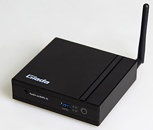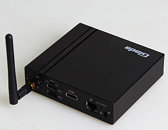Wednesday, August 12th 2015
Giada Announces F200 Fanless Mini PC with 5W Power Consumption
Giada Technology, a provider of Servers, Mini-PCs and embedded motherboards, announces the F200 Thin Client Series Mini-PC for the North American Market. The F200 is an ultra compact 4.6" x 4.2" x 1.2" Mini-PC which can easily mount on the back of monitors and Digital Signage displays. Featuring extremely low 5W power consumption, a dustproof metal chassis, reliable fanless design and 2GB of onboard eMMC flash memory, the F200 is a durable mini-pc suitable for thin client, digital signage, and industrial control applications.
The F200 Mini-PC uses just 5W of power at full load. With most desktop PCs using 100W or more of electricity, the F200 features extreme power savings as a thin client PC. Featuring an ultra compact 4.6" x 4.2" x 1.2" design, the F200 takes up 1/30th the space of a traditional desktop PC. Its small size means it takes up little desktop real estate and it can easily fit on the back of displays and monitors using a VESA mount for a clean installation or digital signage usage.Reliable Metal Chassis and Onboard Memory
Using a fanless design and efficient processor with a durable metal chassis, the F200 generates little heat for high reliability and long service life. The chassis is dustproof, making it suitable for both office and industrial environment. The F200 provides reliable shock and vibration resistant performance with 2GB of DDR3 DRAM and 8GB or an optional 16GB of eMMC flash soldered directly on-board. An mSATA slot allows easy storage expansion.
JAHC Unattended Technology for Digital Signage
The F200's JAHC unattended technology features make it also suited to simple digital signage and industrial installations. Scheduled power on/off, auto power-on after power failures, and more improved the unmanned capability of the F200 allowing it to operate more reliably in the field without constant monitoring and configuration. A SIM card slot allows 3G connectivity for pushing signage content over 3G and the F200 supports HDMI output with Direct X11 and Realtek High Definition Audio.
Features
The F200 Mini-PC uses just 5W of power at full load. With most desktop PCs using 100W or more of electricity, the F200 features extreme power savings as a thin client PC. Featuring an ultra compact 4.6" x 4.2" x 1.2" design, the F200 takes up 1/30th the space of a traditional desktop PC. Its small size means it takes up little desktop real estate and it can easily fit on the back of displays and monitors using a VESA mount for a clean installation or digital signage usage.Reliable Metal Chassis and Onboard Memory
Using a fanless design and efficient processor with a durable metal chassis, the F200 generates little heat for high reliability and long service life. The chassis is dustproof, making it suitable for both office and industrial environment. The F200 provides reliable shock and vibration resistant performance with 2GB of DDR3 DRAM and 8GB or an optional 16GB of eMMC flash soldered directly on-board. An mSATA slot allows easy storage expansion.
JAHC Unattended Technology for Digital Signage
The F200's JAHC unattended technology features make it also suited to simple digital signage and industrial installations. Scheduled power on/off, auto power-on after power failures, and more improved the unmanned capability of the F200 allowing it to operate more reliably in the field without constant monitoring and configuration. A SIM card slot allows 3G connectivity for pushing signage content over 3G and the F200 supports HDMI output with Direct X11 and Realtek High Definition Audio.
Features
- 5W Low power consumption
- Ultra Compact: 4.6" x 4.2" x 1.2"
- Reliable Fanless industrial design
- Dustproof, durable metal chassis
- 2GB onboard DDR3 DRAM and 8GB or 16GB of onboard flash storage
- mSATA slot for storage expansion
- JAHC unattended technology for digital signage
- MSRP: US $110



6 Comments on Giada Announces F200 Fanless Mini PC with 5W Power Consumption
The N2807 is a bay trail atom. :(
The N3050 is a brasswell atom
I have an HP stream mini that is the same form factor with a Celeron 2957u (haswell based)
Total system power draw is the same for double the performance.
I got the new brasswell nuc as the hp stream as they are at competing price points.
It really isn't a pretty fight.That is not wall draw, both the nuc and the stream hit 12w wall draw under cpu load and the nuc did 16w gpu load and the stream 18w gpu load.
But it was much much faster in all benchmarks.
Here is the stream results from linux-bench.
Single channel and Dual channel results in the stream.
I have a feeling the nuc loses some of its efficiency gains due to the 65w wall wart.
The HP stream only has a 45w brick and might gain some ground there.